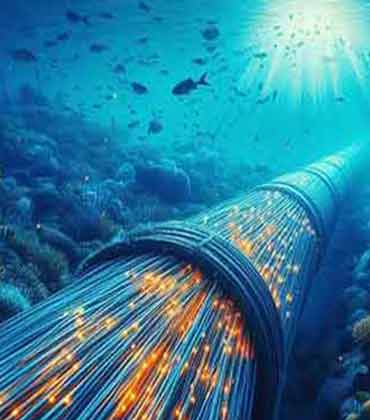THANK YOU FOR SUBSCRIBING
Applied Technology Review: Specials Magazine
Subsea industries operating in extreme ocean conditions require rugged, reliable fiber optic wet mate connectors. Whether it’s oil and gas, renewable energy, or defense, these connectors are essential for uninterrupted data transmission. However, today’s traditional solutions often fall short. Designed for a simpler era, most can accommodate at most 1 to 12 optical fibers and lack the scalability needed to meet modern demands. Additionally, they are prone to misalignment during mating, leaving them vulnerable to contamination by sand and grit, which compromises performance and reliability. The demand for high mateability, centerline actuation, and debris-resistant double seals is greater than ever. Meeting these requirements demands top-tier engineering and R&D expertise, which significantly narrows the field of capable providers. What most saw as an obstacle, Deeplinc envisioned as an opportunity to innovate and set a new standard. A PIONEER IN SUBSEA CONNECTIVITY SOLUTIONS Deeplinc offers an exceptional portfolio of connectors that meet exacting standards. Its product range caters to diverse industry needs while pushing the boundaries of underwater fiber optic technology. Deeplinc has developed a novel, compact fiber optic wet-mate connector capable of supporting up to 48 fibers in small configurations and scaling up to 144 in larger designs, combining robustness with flexibility.
CXO INSIGHTS

Leveraging Geospatial (location-based) Technologies for Efficient Fiber Rollouts and Network Management
Tarik Dixon, GISP, RICS, Head of GIS, Network Design & Operations at Digicel Group

Don't Forget about the Human Element!
Jolene Stewart, Executive Director of Security and Surveillance, Snoqualmie Casino and Hotel

The Next Frontier of AIOPS Where are we Now, Where are We Headed and what will it take to get there?
Frank Kelly, Vice President, Hughes Network Systems

Catalyzing Telecom HR: Tech Advancements, Challenges and Upskilling
Verne Vetrulli, Senior Vice President Global Human Resources, Radius Global Infrastructure

Automation is a Must Have for Service Providers
Pascal Menezes, CTO, MEF Forum
IN FOCUS
Optical Fiber Technology in Modern Communication
Optical Fiber Technology is Vital in Today’s Highspeed Communication Era, Offering Reliability and Performance.
Transforming Global Communication Networks
Submarine optical fiber technology forms the backbone of the modern global communication network, enabling seamless data transmission across continents. These undersea cables are pivotal in supporting internet, telecommunication, and financial
EDITORIAL
The Latest Advancements in Submarine Optical Fiber Technology
The undersea world has always been a frontier of mystery and marvel, but in the 21st century, it has become a linchpin for global connectivity. Submarine optical fiber cables, often likened to the nervous system of the internet, are undergoing transformative advancements, promising faster, more resilient, and greener solutions for the ever-growing data demands of our world. The relentless surge in data consumption, driven by 5G, IoT, and cloud services, has pushed researchers and manufacturers to rethink traditional cable architectures. One of the most significant breakthroughs in recent years is the adoption of space-division multiplexing (SDM). Unlike older technologies that relied on maximizing individual fiber pair capacity, SDM increases the number of fiber pairs within a single cable, improving both capacity and energy efficiency. Current projects aim to deploy cables with up to 32 fiber pairs, far surpassing the previous standard of 12 to 16 pairs. Simultaneously, advances in coherent optical technology have enhanced the ability to transmit data over vast distances without signal degradation. Utilizing new modulation formats and higher-order constellation schemes, cables can now achieve capacities exceeding 800 terabits per second (Tbps), a staggering figure that underscores the progress in optical signal processing. Modern submarine cables are being engineered to withstand harsher environments and deeper waters. The introduction of bend-insensitive fibers and improved armoring ensures these cables remain operational even under extreme pressures or in regions prone to geological activity. Innovations in coating materials have also reduced cable attenuation, leading to more efficient long-distance data transmission. In this edition, we have featured Deeplinc. The company offers an exceptional portfolio of connectors that meet exacting standards. Its product range caters to diverse industry needs while pushing the boundaries of underwater fiber optic technology.










